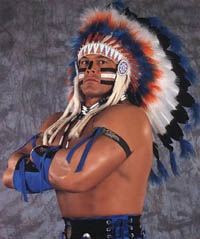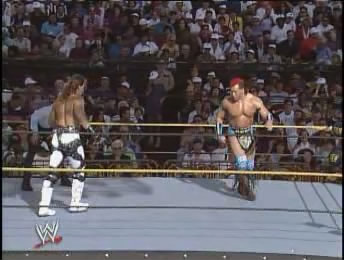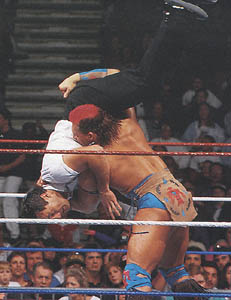“Tatanka” was born Chris Chavis in June of 1961 in Pembroke, North Carolina into the honored Lumbee Tribe, a Native American tribe descended from the Cheraw Indians from centuries ago. Chavis has always been extremely proud of his heritage, and shares some of his tribe’s history on his website. “Tatanka” went on to become a star football player in high school and college, as well as an honor student. When he was enrolled into the Army R.O.T.C. program he was voted “The Best Athlete” in 1978, and rose to the rank of Colonel. He would enjoy some success as a professional bodybuilder and tried out for the N.F.L. where he could’ve taken a free-agent contract with the Miami Dolphins, but eventually he would go on to pursue his dream of becoming a pro-wrestler.
With the help of “Nature Boy” Buddy Rogers, Chavis would join “The Monster Factory” in New Jersey. He would soon wrestle for North American Wrestling Association where he was taken under the wings of wrestling legends Ricky “The Dragon” Steamboat and “Wahoo” McDaniels. Before he was “Tatanka,” Chavis was a Native American wrestler known as “The War Eagle,” and in 1990 was named “Rookie of the Year” by Pro-Wrestling Illustrated. Within one year of starting his wrestling career he was signed to World Wrestling Entertainment.
Chavis would take on the moniker of “Tatanka” and a new look, complete with a red stripe in his hair that signified “the blood and bravery of all the Native Americans.” “Tatanka” vowed to be an inspiration for all Native Americans, and stated, “I will represent all the tribes and I have hopes that one day in the future I will lead a new Native American nation in the WWF. I will be victorious, and I will dedicate my victory to all Native Americans of all tribes.” Running down to the ring after the shriek of a war-cry and the start of his music, “Tatanka’s” look and character was that of a proud Native American who fed off the strength of all Native Americans. This strength would lead to many victories at the start of his WWE career, as he would shrug off his opponents’ attacks with a war-dance that would lead to “Tatanka” going on the offensive, and an eventual victory.
One of “Tatanka’s” first big victories came at “Wrestlemania 8” against “The Model” Rick Martel. “Tatanka” came down to the ring in a Native American ceremonial vest, feathers, and necklace, and was greeted by several members of his Lumbee tribe, also wearing ceremonial head-dress. “Tatanka” was blessed by one of the members of the tribe before the match, and then the tribal members danced and chanted as they headed to the back. “Tatanka” shrieked a war-cry and then went on to defeat the veteran Martel. The site was impressive and you got a real sense of how proud and genuine “Tatanka” felt about his heritage.
“Tatanka” would go on to have a long winning streak that included a run at the Intercontinental (man, that’s a long word) Champion “The Heartbreak Kid” Shawn Michaels at “Wrestlemania 9.” “Tatanka” would be victorious again this day, but as a result of a count-out, and as many of you know titles can only be won with a count of three, not ten. Although he may not have been able to “pull the trigger” this day, “Tatanka” left with his streak intact and “future champ” written all over him.
Despite having his streak ended at the hands of “Ludvig Borga,” and being injured and sidelined by “Borga” and “Yokozuna” before the “Survivor Series” pay-per-view, “Tatanka” would return just as popular and determined as ever to become a top star in the WWE. Eventually he would feud with “Irwin R. Schyster” after “IRS” attacked him and destroyed a ceremonial headdress that was presented to “Tatanka” by legend “Chief Jay Strongbow;” “IRS” also attacked “Strongbow.” Remember this because it is important.
As ’94 progressed “Tatanka” and Lex Luger were scheduled to have a match at the “Summerslam” pay-per-view. The story was that “Tatanka” believed Luger was going to “sell-out” to the “Million Dollar Corporation” and Ted DiBiase. It was in fact “Tatanka” who sold-out to Ted DiBiase, and turned on Luger. “Tatanka,” fighter of the Native American people, had turned his back on them. This is all well and good; in this business people make unpopular decisions all the time. According to one friend of Chavis in a quote off of “Tatanka’s” official website “Tatanka still loved his fans but had to take care of business not for selfish reasons, but for his people; the Native Americans. So remember that, when you call him names and boo him, he’s doing it because he has to.”
Now when a wrestler “turns to the darkside,” so to speak, their character usually takes a new direction or persona. “Tatanka” decided to “wrestle a shark” when he didn’t change a thing. You might be thinking “so what?” This is something that happens regularly. The difference with “Tatanka” is that he still dressed the same, and came to the ring wearing ceremonial jewelry. What helped popularize “Tatanka” as a fan-favorite made the character into a mockery. Remember that “IRS,” who was a member of the “Million Dollar Corporation,” destroyed “Tatanka’s” priceless headdress, something that “Tatanka” took great pride in. Why would “Tatanka” side with someone like this, and not change his persona? Fans loved how legitimately “Tatanka” felt about his heritage, but when he became a heel fans saw that he didn’t change a thing. They not only turned on him, but also turned on who he was as a Lumbee.
This was made very apparent in a match on “Superstars” in ’95 against Shawn Michaels, who had recently turned into a fan favorite earlier in the year. Michaels mocked “Tatanka’s” Native American heritage, and the fans cheered Michaels’ antics. What would have been booed by the fans if a heel did the same was being applauded now that the roles were reversed. If “Tatanka” had changed the little things when he turned, he might have remained a major player instead of a heel stereotype. How could someone with such a specific gimmick go back to being a fan favorite, when he didn’t change a thing as a “bad guy?”
“Tatanka’s” popularity waned in ’95, and he would not regain the same momentum he had from his earlier years in the WWE. “Tatanka” would leave the WWE in ’96 to focus on his family and personal matters. Chavis would eventually make a return to the WWE in 2005 under the “Tatanka” name, and the fans accepted him back proving that time heals, but within a year “Tatanka” would go back to being a “bad guy” attacking fan favorite Bobby Lashley. History once again repeated itself, and “Tatanka” once again didn’t change anything. Fans didn’t appreciate it then and they didn’t appreciate it in ’06. “Tatanka” was released soon after, in January of 2007. “Tatanka” still wrestles independently around the world.




